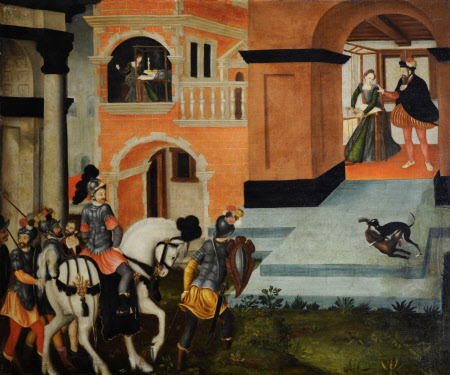The Unannounced Return by Night of L. Tarquinius Collatinus and his Companions to find his Wife Lucretia Weaving
attributed to Jehan Baleschoux (fl.1570)
Category
Art / Oil paintings
Date
1570 (bears date)
Materials
Oil on canvas
Measurements
847 x 1029 mm (33 1/3 x 40 1/2 in)
Place of origin
England
Order this imageCollection
Hardwick Hall, Derbyshire
NT 1129221
Summary
Oil painting on canvas, The Unannounced Return by Night of L. Tarquinius Collatinus and his Companions to find his Wife Lucretia Weaving, attributed to Jehan Baleschoux (fl.1570 - d.c.1618), inscribed on entablature at upper left: 1570. On the left are Roman architectural elements and in the foreground, bottom left is L.Tarquinius Collatinus in armour and plumed helmet mounted on a white horse with his companions standing alongside on foot, also in armour with shields, spears and plumed helmets. He arrives at the arched entrance of a palace, inside which Lucretia is seen, through an arched window, centre left, seated and working at her loom by candlelight. She appears a second time, to right, through a massive arch, standing at her loom, on her left shoulder rests the hand of a Sextus Tarquinius in doublet and trunk-hose typical of the 1570s who stands beside her. On a stepped courtyard in front of them are two dogs sniffing each other. The figures wear contemporary sixteenth-century dress although the original story is related by the Roman historian Livy 1: 57-9 and alludes to Bess of Hardwick who had already begun by 1570 to represent herself to the frequently absent Earl of Shrewsbury as the virtuous wife diligently working at her embroideries. Significantly, Lucretia was the subject of an appliqué wallhanging which still survives at Hardwick and Bess named her youngest daughter after the heroine. The painting is not an original composition but represents the careful amalgamation of two woodcuts designed by Jost Amman for the Lutheran Bible published in Frankfurt in 1564: the arched structure on the extreme left and the group of soldiers were copied from Amman's illustration of the Triumph of Mordecai, in the Bible's Old Testamant (Esther 6), while the rest of the architecture including the stepped plinth and the brawling dogs were lifted from Amman's Nebuchadnezzar's Dreams, also in the Bible's Old Teastament (Daniel 2). Lucretia (6th century BC) was the Roman wife of L. Tarquinius Collatinus. She was raped by Sextus Tarquinius, son of Lucius Tarquinius Superbus (the Proud) traditionally the 7th and last king of Rome (734-510 BC). She summoned her husband and friends, and, making them take an oath to drive out the Tarquins, plunged a knife into her heart. The Tarquins were later expelled by Lucius Junius Brutus, the legendary Roman hero, who established Republican government. The artist, also called John Balechouse, a painter of hitherto uncertain origin worked for the Shrewsbury family at Chatsworth from no later than 1578 until after the death of Bess of Hardwick in 1608.
Provenance
In 1601 Inventory of the contents of Hardwick Hall (the will of Elizabeth Hardwick, Countess of Shrewsbury [c.1520-1608]) as 'Ulisses and Penelope'; and thence by descent until, following the death of Edward William Spencer Cavendish, 10th Duke of Devonshire (1895 - 1950), Hardwick Hall and its contents were accepted by HM Treasury in part payment of death duties and transferred to the National Trust, in 1959
Credit line
Hardwick Hall, The Devonshire Collection (acquired through the National Land Fund and transferred to The National Trust in 1959)
Makers and roles
attributed to Jehan Baleschoux (fl.1570), artist British (English) School, artist previously catalogued as attributed to Hans Eworth (Antwerp c.1525 – ?London after 1578), artist
References
Waterhouse 1994 Ellis K. Waterhouse, Painting in Britain 1530-1790, Pelican History of Art, Harmondsworth, [1st Pub.1953], 1994 ed., p. 17 Strong 1969 Roy Strong, The English Icon, Elizabethan and Jacobean Portraiture, London, 1969, p.41, fig.35 Wells-Cole 1997 Anthony Wells-Cole, Art and Decoration in Elizabethan and Jacobean England: the influence of continental prints, 1558-1625, New Haven & London 1997, pp.250-51, 290-92, 391 n.92, and colour plates 423 & 498.

